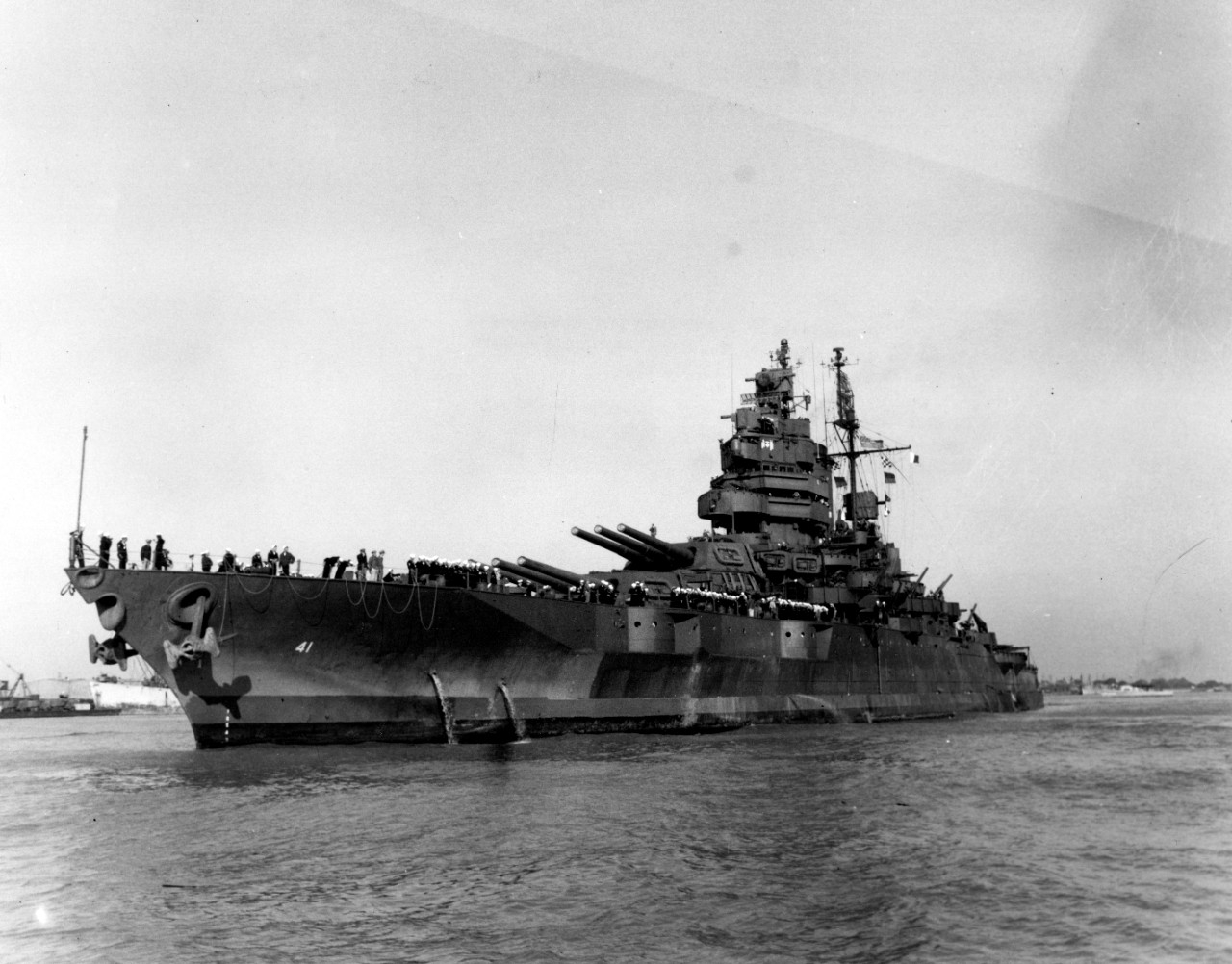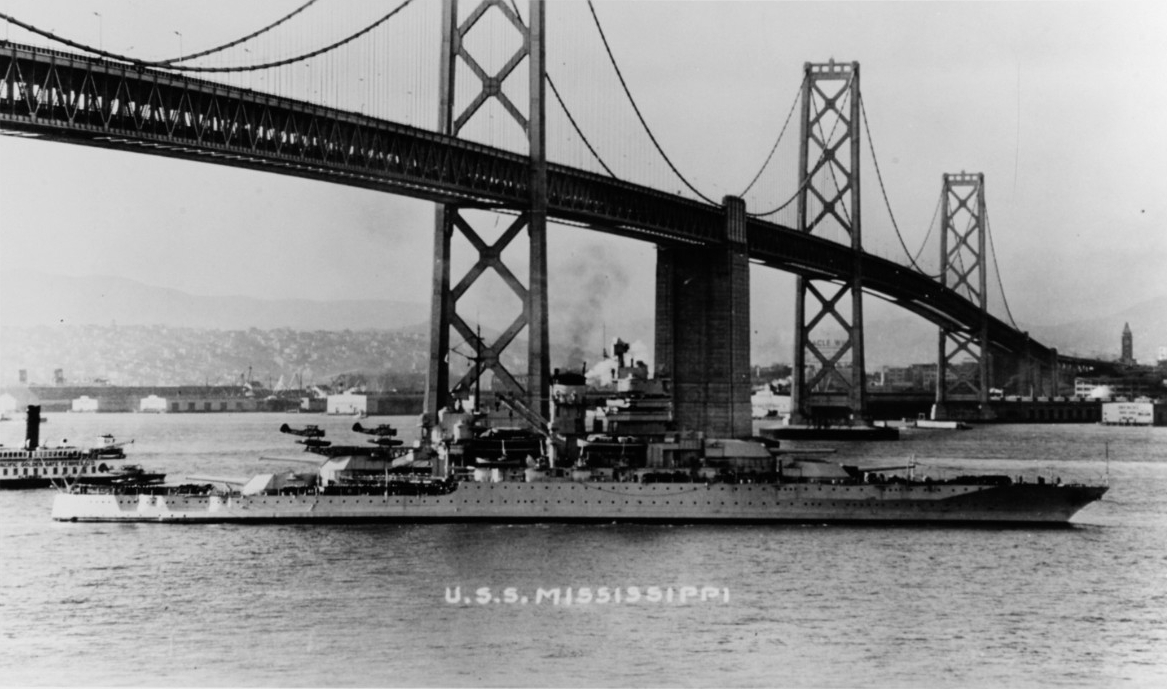Mississippi III (Battleship No. 41)
1917-1956
Mississippi (BB-41) in the Mississippi River, en route to take part in Navy Day celebrations at New Orleans, Louisiana, 16 October 1945. Note her anchors suspended below their normal stowed position at the bow. Photograph from the Army Signal Corps Collection in the U.S. National Archives, SC 215864.
The first Mississippi was named for the Mississippi River; succeeding ones for the 20th State, admitted to the Union 10 December 1817.
III
(Battleship No. 41: displacement 32,000; length 624'0"; beam 97'5"; draft 30'0"; speed 21.0 knots; complement 1,081; armament 12 14-inch, 14 5-inch, 4 3-inch, 2 21-inch torpedo tubes; class New Mexico)
The third Mississippi (Battleship No. 41) was laid down on 5 April 1915 at Newport News, Virginia, by Newport News Shipbuilding Co.; launched on 25 January 1917; sponsored by Miss Camelle McBeath; and commissioned on 18 December 1917, Capt. J. L. Jayne in command.
Following exercises off Virginia, Mississippi steamed 22 March 1918 for training in the Gulf of Guacanayabo, Cuba. One month later she returned to Hampton Roads and cruised between Boston and New York until departing for winter maneuvers in the Caribbean 31 January 1919. On 19 July she left the Atlantic seaboard and sailed for the west coast. Arriving at her new base, San Pedro, Calif., she operated along the west coast for the next four years, entering the Caribbean during the winter months for training exercises. During that time, on 17 July 1920, she was redesignated as BB-41.
During gunnery practice on 12 June 1924 off San Pedro, 48 of her men were asphyxiated as a result of an explosion in her main battery turret II. On 15 April 1925 she sailed from San Francisco for war games off Hawaii, and then steamed to Australia on a good will tour. She returned to the west coast on 26 September, and resumed operations there for the next six years. During this period she frequently sailed into Caribbean and Atlantic waters for exercises during the winter months.
Mississippi entered Norfolk Navy Yard on 30 March 1931 for a modernization overhaul, departing once again on training exercises in September 1933. Transiting the Panama Canal on 24 October 1934, she steamed back to her base at San Pedro. For the next seven years she operated off the west coast, except for winter Caribbean cruises.
Returning to Norfolk on 15 June 1941, she prepared for patrol service in the North Atlantic. Steaming from Newport, R.I., she escorted a convoy to Hvalfjordur, Iceland. She made another trip to Iceland on 28 September 1941, and spent the next two months there protecting shipping.
Stricken frpTwo days after the attack on Pearl Harbor, Mississippi left Iceland for the Pacific. Arriving on 22 January 1942 at San Francisco, she spent the next seven months training and escorting convoys along the coast on 6 December 1942, after participating in exercises off Hawaii, she steamed with troop transports to the Fiji Islands, returning to Pearl Harbor 2 March 1943. On 10 May she sailed from Pearl Harbor to participate in a move to restore the Aleutians. Kiska Island was shelled 22 July, and a few days later the Japanese withdrew. After overhaul at San Francisco,Mississippi sailed from San Pedro 19 October to take part in the invasion of the Gilbert Islands. While bombarding Makin 20 November, a turret explosion, almost identical to the earlier tragedy, killed 43 men.
On 31 January 1944 she took part in the Marshall Islands campaign, shelling Kwajalein. She bombarded Taroa 20 February, and blasted Wotje the next day. On 15 March she pounded Kavieng, New Ireland. Due for an overhaul, she spent the summer months at Puget Sound.
Returning to the war zone, Mississippi supported landings on Peleliu, in the Palau Islands, on 12 September. After a week of continuous operations she steamed to Manus, where she remained until 12 October. Departing Manus, she assisted in the liberation of the Philippines, shelling the east coast of Leyte on 19 October. On the night of the 24th, as part of Vice Adm. Jesse B. Oldendorf's battleline, she helped to destroy a powerful Japanese task force at the Battle of Suriago Strait. As a result of the engagements at Leyte Gulf, the Japanese navy was no longer able to mount any serious offensive threat.
Mississippi continued to support the operations at Leyte Gulf until 16 November, when she steamed to the Admiralty Islands. She then entered San Pedro Bay, Leyte, 28 December, to prepare for the landings on Luzon. On 6 January 1945 she began bombarding in Lingayan Gulf. Despite damages near her waterline received from the crash of a suicide plane, she supported the invasion forces until 10 February. Following repairs at Pearl Harbor, she sailed to Nakagusuku Wan, Okinawa, arriving 6 May to support the landing forces there. Her powerful guns leveled the defenses at Shuri Castle, which had stalled the entire offensive. On 5 June, a kamikaze crashed into her starboard side, but the fighting ship continued to support the troops at Okinawa until 16 June.
After the announced surrender of Japan, Mississippi steamed to Sagami Wan, Honshu, arriving on 27 August 1945 as part of the support occupation force. She anchored in Tokyo Bay, witnessed the signing of the surrender documents, and steamed for home on 6 September.
She reached Norfolk on 27 November 1945, where she underwent conversion to an auxiliary, AG‑128, effective 15 February 1946. As part of the operational development force, she spent the last decade of her career carrying out investigations of gunnery problems and testing new weapons, while based at Norfolk. She helped launch the Navy into the age of the guided‑missile warship when she successfully test fired the Terrier missile on 28 January 1953 off Cape Cod. She also assisted in the final evaluation of the Petrel, a radar‑homing missile, in February 1956.
Stricken from the List of Naval Vessels on 30 July 1956, Mississippi was decommissioned at Norfolk on 17 September 1956, and was sold for scrapping to the Bethlehem Steel Co., on 28 November of the same year.
Mississippi received eight battle stars for her World War II service.
Interim update, Robert J. Cressman
31 October 2023




